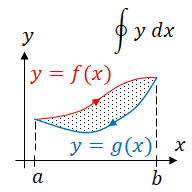Integration Formulas and the Net Change Theorem
Contents
Indefinite integral identities
Basic Properties of Indefinite Integrals
Constant Rule for indefinite integrals
- If is a constant then }}
Sum/Difference Rule for indefinite integrals
- }}
Indefinite integrals of Polynomials
Say we are given a function of the form, , and would like to determine the antiderivative of . Considering that
we have the following rule for indefinite integrals:
Power rule for indefinite integrals
- for all
Integral of the Inverse function
To integrate , we should first remember
Therefore, since is the derivative of we can conclude that
Note that the polynomial integration rule does not apply when the exponent is . This technique of integration must be used instead. Since the argument of the natural logarithm function must be positive (on the real line), the absolute value signs are added around its argument to ensure that the argument is positive.
Integral of the Exponential function
Since
we see that is its own antiderivative. This allows us to find the integral of an exponential function:
Integral of Sine and Cosine
Recall that
So is an antiderivative of and is an antiderivative of . Hence we get the following rules for integrating and
Example
Suppose we want to integrate the function . An application of the sum rule from above allows us to use the power rule and our rule for integrating as follows,
.
Recognizing Derivatives and Reversing Derivative Rules
If we recognize a function as being the derivative of a function , then we can easily express the antiderivative of :
For example, since
we can conclude that
Similarly, since we know is its own derivative,
The power rule for derivatives can be reversed to give us a way to handle integrals of powers of . Since
we can conclude that
or, a little more usefully,
Finding Area or Net Change Between Curves
Finding the area between two curves, usually given by two explicit functions, is often useful in calculus.
In general the rule for finding the area between two curves is
or
If f(x) is the upper function and g(x) is the lower function
This is true whether the functions are in the first quadrant or not.
Area between two curves
Suppose we are given two functions and and we want to find the area between them on the interval . Also assume that for all on the interval . Begin by partitioning the interval into equal subintervals each having a length of . Next choose any point in each subinterval, . Now we can 'create' rectangles on each interval. At the point , the height of each rectangle is and the width is . Thus the area of each rectangle is . An approximation of the area, , between the two curves is
- .
Now we take the limit as approaches infinity and get
which gives the exact area. Recalling the definition of the definite integral we notice that
- .
This formula of finding the area between two curves is sometimes known as applying integration with respect to the x-axis since the rectangles used to approximate the area have their bases lying parallel to the x-axis. It will be most useful when the two functions are of the form and . Sometimes however, one may find it simpler to integrate with respect to the y-axis. This occurs when integrating with respect to the x-axis would result in more than one integral to be evaluated. These functions take the form and on the interval . Note that are values of . The derivation of this case is completely identical. Similar to before, we will assume that for all on . Now, as before we can divide the interval into subintervals and create rectangles to approximate the area between and . It may be useful to picture each rectangle having their 'width', , parallel to the y-axis and 'height', at the point , parallel to the x-axis. Following from the work above we may reason that an approximation of the area, , between the two curves is
- .
As before, we take the limit as approaches infinity to arrive at
- ,
which is nothing more than a definite integral, so
- .
Regardless of the form of the functions, we basically use the same formula.
Resources
- Indefinite Integral, Wikibooks: Calculus
- Area, Wikibooks: Calculus
- Recognizing Derivatives and Substitution Rule, Wikibooks: Calculus
- Net Change Theorem, Definite Integral & Rates of Change Word Problems, Calculus by the Organic Chemistry Tutor
Licensing
Content obtained and/or adapted from:
- Indefinite Integral, Wikibooks: Calculus under a CC BY-SA license
- Area, Wikibooks: Calculus under a CC BY-SA license








































![{\displaystyle [a,b]}](https://wikimedia.org/api/rest_v1/media/math/render/svg/9c4b788fc5c637e26ee98b45f89a5c08c85f7935)







![{\displaystyle {\bigl [}f(x_{i}^{*})-g(x_{i}^{*}){\bigr ]}\Delta x}](https://wikimedia.org/api/rest_v1/media/math/render/svg/3efcbd6878b1c9c84285d7123766c63013ad35fe)

![{\displaystyle A:=\sum _{i=1}^{n}{\Big [}f(x_{i}^{*})-g(x_{i}^{*}){\Big ]}\Delta x}](https://wikimedia.org/api/rest_v1/media/math/render/svg/b532cb175e18edf6dc343ec2abc5acbf183415b7)
![{\displaystyle A=\lim _{n\to \infty }\sum _{i=1}^{n}{\Big [}f(x_{i}^{*})-g(x_{i}^{*}){\Big ]}\Delta x}](https://wikimedia.org/api/rest_v1/media/math/render/svg/66f6dd23a75bdf922a3a92f28772310ab80f2805)


![{\displaystyle [c,d]}](https://wikimedia.org/api/rest_v1/media/math/render/svg/d85b3b21d6d891d97f85e263d394e3c90287586f)







![{\displaystyle A:=\sum _{i=1}^{n}{\Big [}f(y_{i}^{*})-g(y_{i}^{*}){\Big ]}\Delta y}](https://wikimedia.org/api/rest_v1/media/math/render/svg/8670a382efc3d742ae073ca7fc9f2f77fda78423)
![{\displaystyle A=\lim _{n\to \infty }\sum _{i=1}^{n}{\Big [}f(y_{i}^{*})-g(y_{i}^{*}){\Big ]}\Delta y}](https://wikimedia.org/api/rest_v1/media/math/render/svg/9682357a788e80bae02a003b2ac2a10beb6bbc1a)

